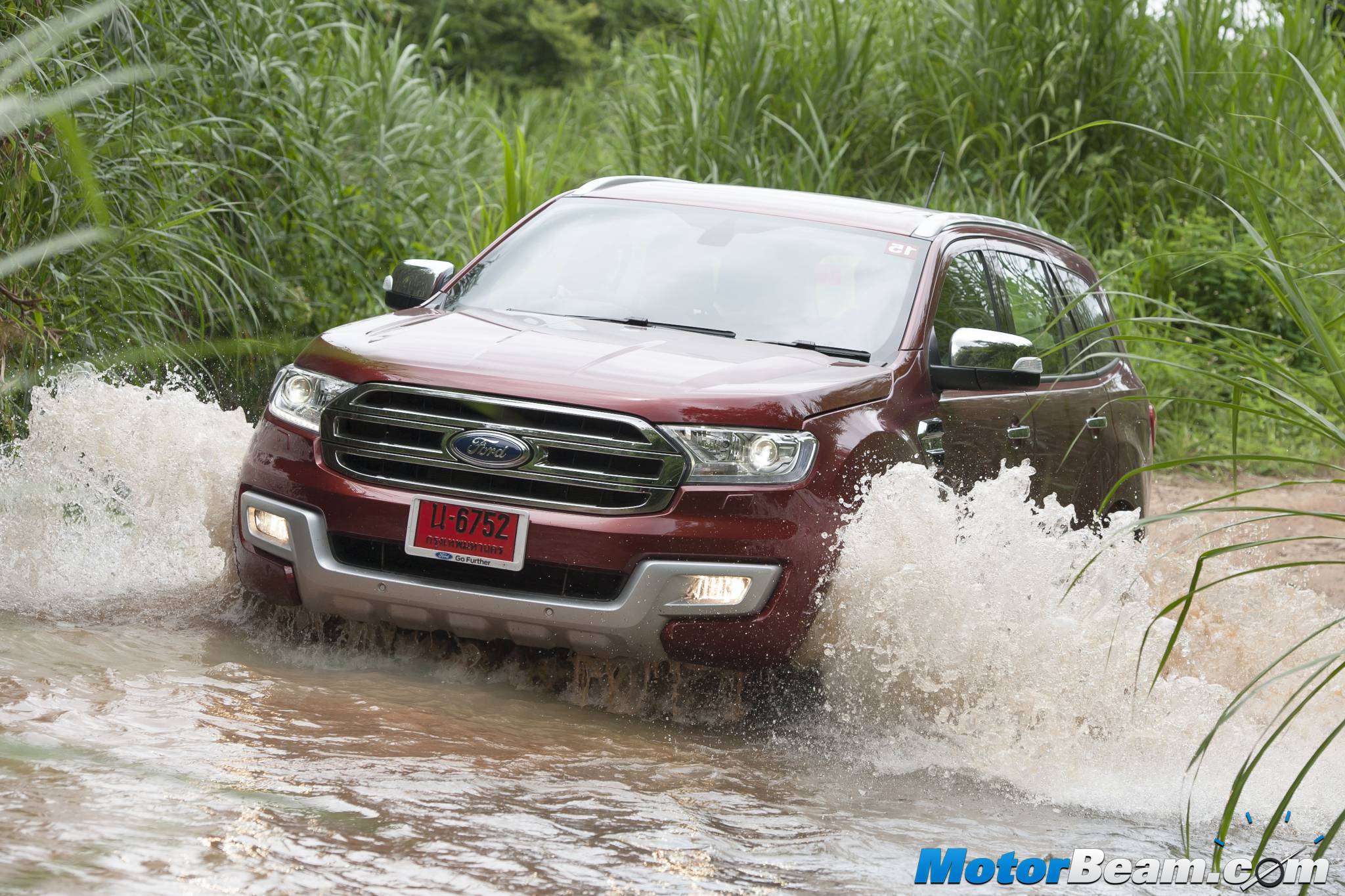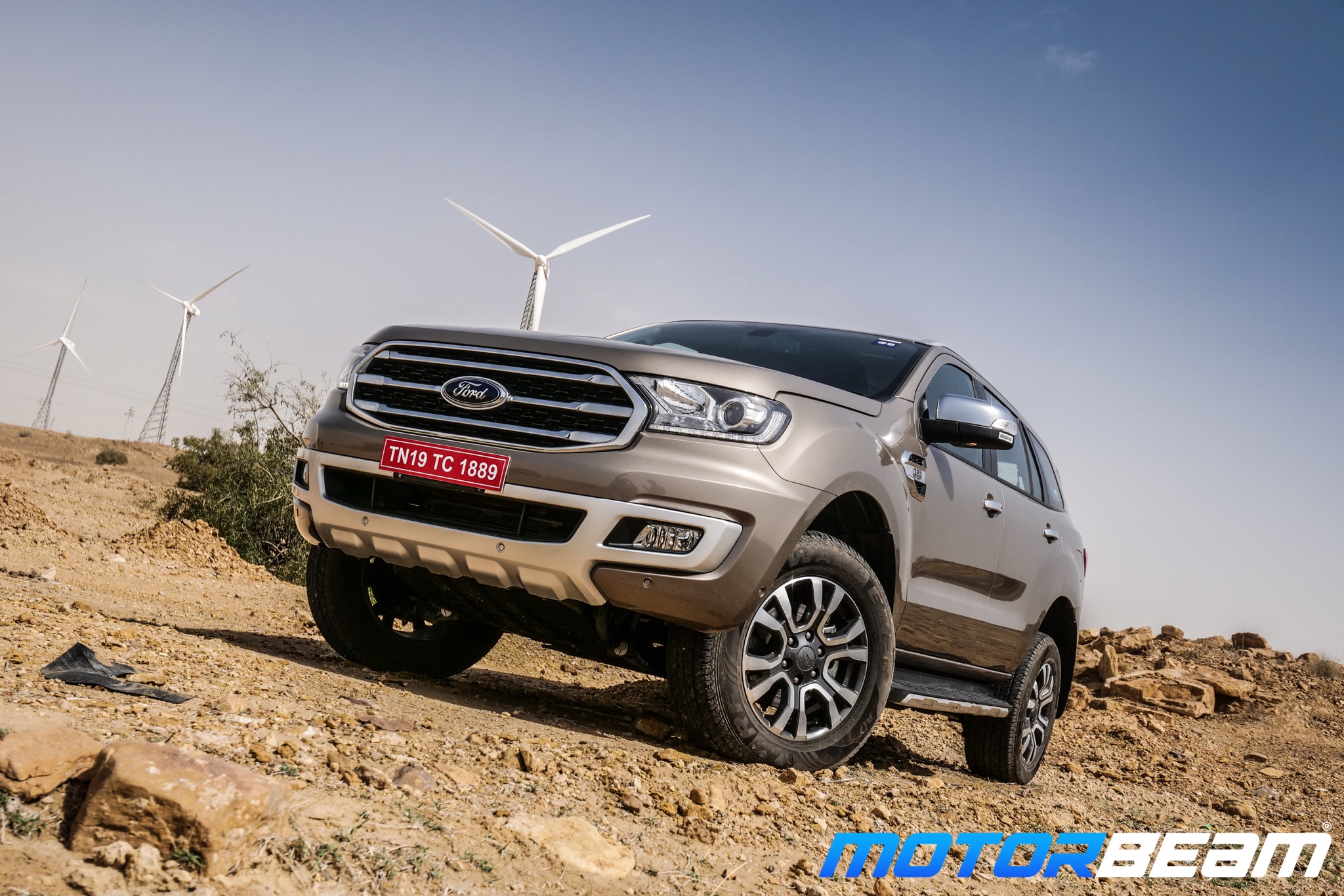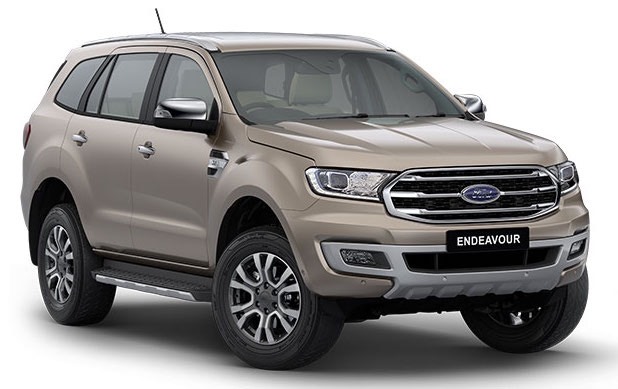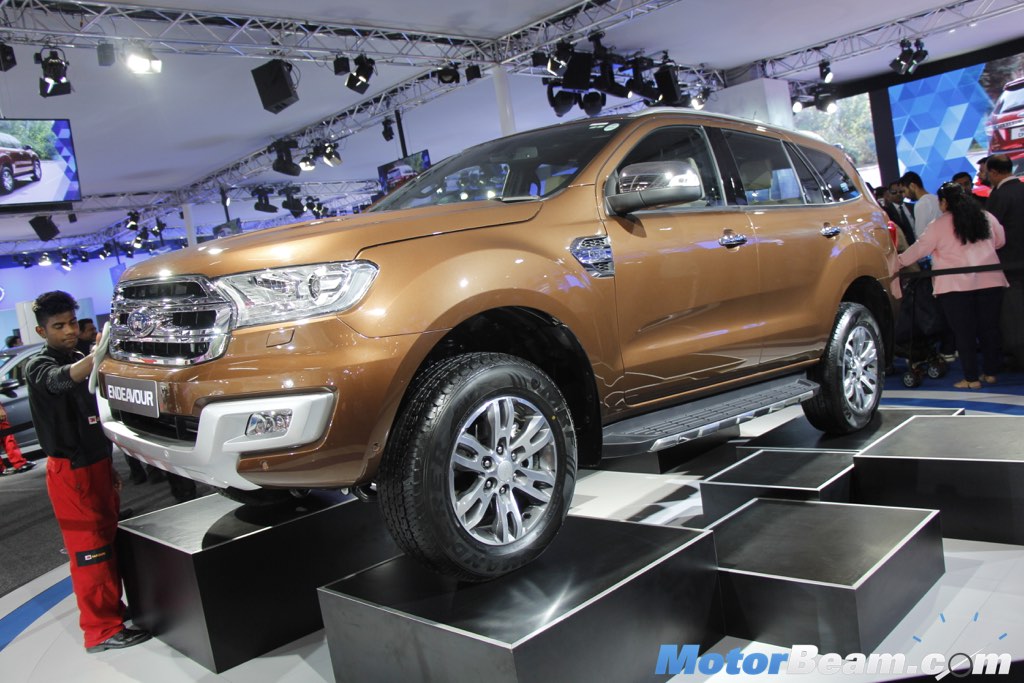
Car Tested: 2015 Ford Endeavour 3.2 4×4
Price OTR Mumbai: Rs. 29.04 – Rs. 34.54 lakhs
The new Endeavour is a big leap forward over its predecessor in every possible way
The Endeavour has been a very important product in Ford’s Indian portfolio since it was launched in 2003. It not only served as the American automaker’s flagship offering but took the market by storm and developed a somewhat cult following. The second generation Endeavour followed but competition got tough when Toyota launched the Fortuner in India. The Endeavour being there since long, started to look old and dated. Meanwhile Ford launched their compact SUV, the EcoSport in India which was an instant hit. Demand for the SUV body style has been growing quickly and Ford is all set to bring the third generation Endeavour to Indian shores to fill the gap at the top end of its SUV portfolio in India. The Endeavour is a very important product in Ford’s range of SUVs. Not only is the demand increasing, Ford reckons that by 2020, the segment will gross nearly 50,000 cars in India which currently stands at about 20,000 vehicles. We got behind the wheel of this all new SUV in Thailand for a quick drive and pen down our initial impressions.
Motor Quest: The Endeavour is known as the Everest globally and is known by that name in more than 150 countries where it is present. The Endeavour name has been adopted only for the Indian market and the primary reason is Ford not being able to get the ‘Everest’ trademark in India. The trademark for Everest is owned by Everest Masala and there are few other brands which use the same name such as Everest Cycles.
The new Endeavour is offered with a range of exciting and youthful colours
Exteriors – The design has evolved into a very catchy one. Based on a brand new T6 platform (partly shared with the Ford Ranger), the new Endeavour has evolved into a much more sportier SUV with high visual appeal. The front gets a bold muscular hood with all chrome trapezoidal front grille, which is bound to be a hit with Indians. The 3D designed skid plate is designed to maximise aerodynamic efficiency. The headlamps feature DRLs with projector lamps. The tail gate now opens upwards and not sideways.
The Endeavour hasn’t gone soft and continues with the macho appeal in the new gen
The all new Ford Endeavour boasts of some serious presence
Muscular wheel arches, highly contoured side panels and the rugged 20-inch alloys give the Endeavour a very dynamic stance. Ford has worked hard in the aerodynamics department to achieve a COD of 0.389 which not only works on the efficiency front but also lends lower wind noise and NVH. The rear gets chiselled out tail-lamps with LED lights with some aerodynamic elements on the sides of the rear glass. The obvious change from the previous generation model is that Ford has ditched the tailgate mounted spare wheel which now sits under the chassis for lower centre of gravity.
Nicely laid out dashboard has quite a few buttons but doesn’t look cluttered
Interiors – The cabin feels very premium with fit and finish being of the finest order, something like what the Germans take pride at. The 3.2-litre, 4WD model we drove sported a dual tone arrangement with dark brown leather and beige arrangement. Also on the dashboard is a glossy metal grey panel with chrome surrounds around the AC vents. However, the 2.2-litre 2WD variant skips the leather part and has a dark dashboard theme, probably for the Chinese market. Rest assured the Indian spec vehicle will get the beige. The 2.2-litre also skipped on the revering camera seen on the 3.2-litre car and did with parking sensors instead. There are of SUV elements inside the cabin such as grab rails on the the A and B pillar. The panoramic sunroof adds a sense of spaciousness to the cabin.
Neatly laid out buttons next to the gear lever are for off-road functions
The Endeavour’s cabin has a ton of storage spaces
There are about 30 storage spaces inside the cabin for odds and ends and the glovebox is big enough to fit in a 16-inch laptop. The 8-inch touchscreen infotainment system uses 10 speakers with integrated subwoofer to deliver some great sound quality. The Endeavour gets the latest version of SYNC (SYNC V2.0) which is more intuitive than before and can understand over 10,000 commands but understanding the Indian accent is not that easy. Other highlights include a dual zone climate control with individual AC vents on the roof for all passengers. The middle row also gets adjustment for fan speed and temperature. There are 12V power sockets in each of the rows with the middle row also getting a 230V power outlet to charge your laptop on the go. The cabin quietness is exceptional and Ford has used sound deadening materials along with ‘Active Noise Cancellation’ which uses three interior microphones to cancel out the low frequency sound, similar to the tech used in high end headphones.
The cabin feels very airy thanks to the usage of beige and dual panoramic roofs
The seats are comfortable with good cushioning and back support but thigh support is not the best for tall passengers. The high seating position gives you a clear view of the terrain ahead and large external rear-view mirrors give you a wider perspective of what is happening behind. Both the front seats get electric adjustment with manual lumbar support adjustment. The second row has 60:40 split seats with centre armrest and head rests for three passengers. The seats can also recline to have a somewhat sofa like seating position. Legroom is sufficient in both the first and second rows. The last row is be suited for kids and for the first time in the segment, the Endeavour gets power-fold function where both the last row seats can be folded individually by the press of a button in 50:50 ratio. Lock/unlock buttons are there on all the four doors.
Rear seat has good amount of space and the car has quite a lot of equipment
The folded seats form a flat floor adding to the versatility. If you need to stow more luggage, the middle row too folds flat thereby increasing boot space to 2010 litres. The tailgate too gets a power open/close function. Other features include ‘Curve Control’ (the car will cut power if you take a curve too fast, will judge based on steering input and speed), ‘Blind Spot Information System’ with Cross Traffic Alert and Lane Departure Warning but these features will most definitely not make it to India for the lack of practicality in the Indian market. However, Ford officials categorically said that the India spec car will be more or less identical.
Two diesel engines will be offered in India and both offer good output
Performance – Powering the third generation Ford Endeavour are an option of two oil-burners. The 3.2-litre DuraTorq 5-cylinder TDCi engine and the 2.2-litre DuraTorq 4-cylinder TDCi diesel mill. We spent maximum time behind the wheel of the 3.2-litre motor. Refinement levels are fantastic with the engine barely audible at idle. Inspite of having an odd number of cylinders, there is absolutely no vibration. This motor produces 197 HP of power and 470 Nm of twisting force. Power delivery is quick and pretty much linear. The motor feels very torquey and will appeal to those who indulge in a lot of off-road activity and engage in heavy duty towing. The 3.2-litre test car was 4WD while the 2.2-litre one was 2WD. Due to restricted speed limits in the city, we were unable to test this motor extensively and will reserve our final verdict until we drive it at length in India.
The 3.2-litre diesel has a terrific mid-range punch and pulls with zest
The massive torque from the 3.2-litre mill gives it good punchy response
The 2.2-litre diesel unit produces 158 HP of power and 385 Nm of torque. This engine is likely to be the motor of choice for most in India as it delivers a good blend of power and efficiency. The 4×2 variant mated to this engine is expected to be the highest selling version when the third gen Endeavour is launched in India. The power delivery is quite decent however the higher torque on the 3.2-litre engine makes it our choice between the two. Power delivery is good and the engine ambles around the 1800 RPM mark while doing 100 km/hr on the highway, making it quite efficient. Though we don’t have the fuel efficiency figures yet, it is projected to be the most fuel efficient engine in its class. Ford will introduce its only petrol engine on the Endeavour, the 2.0-litre EcoBoost, in the Chinese market.
NVH levels in the cabin are terrific and the Endeavour is very silent inside
Our test cars were Thai spec vehicles and came with a 6-speed automatic transmission. However, Ford will offer a 6-speed manual gearbox on the India spec car as standard. The Endeavour does not get push button start and there is a reason for that. While off-roading, if you happen to stall the car, the push button start sequence will require you to get into neutral, depress the clutch which could prove to be time consuming and could be dangerous in extreme off-road conditions. Therefore based on customer feedback, Ford has opted for a regular start with a special ‘Crank-in-Gear’ feature which will allow you to restart a stalled vehicle in low-range four-wheel drive without pressing the clutch pedal. Both the engines run a variable geometry turbo with high injection pressure.
The AT is a single-clutch unit but adapts to the driver by learning his driving style
The 6-speed automatic transmission will also debut in the Indian car. This single clutch transmission has ratios suited for all types of driving conditions. In routine driving conditions, the transmission feels apt but when you floor the pedal to the metal, it does feel a bit laggy owning to its single clutch nature. Ford engineers told us that a dual-clutch automatic would not be able to handle the torque and would also add to the cost. However, Ford has got this thing working better by an additional software which runs along with the gearbox. The transmission ‘learns’ the driving style based on the throttle inputs and changes the settings accordingly. It interacts with the Electronic Stability Program (ESP) and recognises performance based driving based on rapid acceleration and enthusiastic cornering and adapts the modes accordingly. This results in improved engine and transmission efficiency. This transmission also offers ‘Sports Shift’ feature which allows the driver to select the gears manually.
The Endeavour inspires more confidence than before, offers more feedback
Driving Dynamics – The Ford Endeavour has improved vastly over the previous generation model when it comes to driving dynamics. The new Endeavour strikes a good balance between rugged capability and refinement. The ride quality is much better now thanks to the coil-over-strut front suspension and coil springs at the rear. The ride quality for the rear passengers is vastly improved now. Small undulations on the road don’t unsettle the Endeavour but we will wait for a full blown test in India before coming to a conclusion. The previous generation model used a leaf-spring rear suspension arrangement.
Ride quality has seen quite an improvement over the outgoing model
Efforts to improve the balance of this Ford SUV have paid off very well
Bodyroll is inevitable in a body-on-frame type of construction but is well controlled. This type of construction makes it quite good when it comes to off-roading but on the highway, the handling is not as it would be with a monocoque. However, the handling is now more predictable. The steering feels light at low speeds and weighs up pretty well as speeds pick up. Ford has used Watt’s linkage on the rear suspension which allows the suspension to move up and down with minimum sideways movement, thereby improving the handling characteristics. Moreover, the 20-inch wheels aided in shaper dynamics. Though handling is vastly improved over the previous generation model, we will do an extensive test before being too judgemental. Braking performance is quite good. The brakes bite well and even with the weight, stop the car in a predictable manner. The 265/50 tyres offer good grip.
The Endeavour is as capable as ever, gets ‘Terrain Management System’ too
Off-Road Ability – Now to the most important aspect of the new Ford Endeavour – off-road capability. The Endeavour is bound to please both the soft roader and the off-road junkie. The vehicle has a ground clearance of 225 mm and the best-in-class water wading ability of 800 mm. Moreover, the 29 degree approach angle, 21 degree ramp-over angle and 25 degree departure angle make it able in every kind of scenario. The Endeavour features a segment first ‘Terrain Management System’ which fine tunes the throttle response, transmission, traction control and four-wheel drive system based on the driving conditions. There are 4 modes on the system, first being Normal, second Snow, Mud, Grass with the third and fourth being Sand and Rock respectively. This system is similar to the ‘Terrain Response System’ seen on the Land Rovers but it was developed by Ford at the time when it owned Jaguar and Land Rover.
The cluster shows an array of data when off-roading, helping to quite an extent
The 4WD variant gets full time 4-wheel drive. In the normal mode there is a 60:40 torque distribution between the rear and front wheels. However, torque distribution can even go to 98:2 in case of extreme conditions and wheel slip. You can electronically lock the rear differential with the push of a button. This will prevent the rear wheels from spinning, increasing traction in challenging conditions. Ford has also equipped the Endeavour with ‘Active Transfer Case’ which provides two speed four-wheel drive operation – the high range (1:1) and low range (2.48:1). Torque on demand via the Active Transfer Case maximises off-road performance by continuously calculating and adjusting the torque distribution to the wheels on the ground, braking the ones in the air. It also automatically transfers torque between front and rear wheels for maximum traction in tricky conditions. The Endeavour also gets ‘Hill Descent Control’. The instrument cluster also shows an off-road display which shows pitch, roll and steering angle, enabling you to know which way the wheels are pointing.
The 2015 Ford Endeavour comes with a long list of safety kit
Safety and After Sales Service – The Ford Endeavour has a list of safety features such as 7 airbags (including knee airbag), Electronic Stability Control (ESP), Hill Launch Assist, Active Park Assist and Roll Stability Control which uses gyroscopic sensors to detect fast cornering or sharp swerving, selectively applying individual brakes to reduce the likelihood of a rollover. Ford’s service has improved drastically and the company has been expanding its dealership network quickly to reach more markets.
The new Endeavour has to take on new gen models from Toyota and Mitsubishi
Verdict – The third generation Ford Endeavour has drastically improved over its predecessor and packs in a lot of technology with few segment first features. We reckon it will surely give the Toyota Fortuner a run for its money. It is likely to be priced in the same range as the Fortuner and will make its debut in India within the next six months. If the initial impressions are anything to go by, this SUV is something to watch out for in the coming months and the segment is poised for an intense battle, perfectly justifying its tagline ‘Engineered for Extraordinary’.
The new Endeavour is a serious attempt by Ford to get to the top of the segment. The Endeavour appeals to the urban buyer as well as the hardcore SUV fanatic. Packed with some great technology, powerful and efficient engines it finds the perfect balance between comfort and off-road capability and should appeal to a large section of buyers in India.
We are sure to see a lot of white Endeavours in India as this is a terrific product
What’s Cool
* Bold design, hasn’t gone soft on the design front like its rivals
* Loaded cabin with a ton of features, interior feels top-class too
* Improved ride and handling, ditches the leaf spring suspension
* Super silent cabin, it’s very quiet on the inside
* New off-road system makes it a walk in the park to conquer unknown terrains
What’s Not So Cool
* Automatic gearbox isn’t the quickest around, takes its time to shift when driving enthusiastically
Alternatives: Toyota Fortuner, Mitsubishi Pajero Sport, Chevrolet TrailBlazer




